Wildfire Effects on Cryosols in Central Yakutia Region, Russia
Abstract
1. Introduction
- -
- To evaluate the main soil properties affected by the forest fires of the Yakutia region in 2021;
- -
- To assess heavy metal contents and the peculiarities of their migration in soils of pyrogenic origin;
- -
- To analyze the vertical pattern of apparent electrical resistivity in soils.
2. Materials and Methods
2.1. Study Site and Soil Sampling
2.2. Chemical Analyses of the Fine-Earth of Soils
3. Results and Discussion
4. Conclusions
Author Contributions
Funding
Institutional Review Board Statement
Informed Consent Statement
Data Availability Statement
Acknowledgments
Conflicts of Interest
References
- Doerr, S.H.; Santın, C. Global trends in wildfire and its impacts: Perceptions versus realities in a changing world. Philos. Trans. R. Soc. B 2016, 371, 20150345. [Google Scholar] [CrossRef] [PubMed]
- San-Miguel-Ayanz, J.; Durrant, T.; Boca, R.; Liberta, G.; Branco, A.; de Rigo, D.; Ferrari, D.; Maianti, P.; Arts Vivancos, T.; Schulte, E.; et al. Forest Fires in Europe, Middle East and North Africa 2016; European Commission: Luxembourg, 2017; 126p. [Google Scholar] [CrossRef]
- Tarasov, P.A.; Ivanov, V.A.; Ivanova, G.A.; Krasnoshchekova, E.N. Postpyrogenic changes in the hydrothermal parameters of soils in middle-taiga pine forests. Eurasian Soil Sci. 2011, 44, 731–738. [Google Scholar] [CrossRef]
- Bento-Goncalves, A.; Vieira, A.; Ubeda, X.; Martin, D. Fire and soils: Key concepts and recent advances. Geoderma 2012, 191, 3–13. [Google Scholar] [CrossRef]
- Abakumov, E.; Maksimova, E.; Tsibart, A. Assessment of postfire soils degradation dynamics: Stability and molecular composition of humic acids with use of spectroscopy methods. Land Degrad. Dev. 2017, 29, 2092–2101. [Google Scholar] [CrossRef]
- Gonzalez-Perez, J.A.; Gonzalez-Vila, F.J.; Almendros, G.; Knicker, H. The effect of fire on soil organic matter—A review. Environ. Int. 2004, 30, 855–870. [Google Scholar] [CrossRef]
- Imeson, A.C.; Verstraten, J.M.; van Mulligen, E.J.; Sevink, J. The effects of fire and water repellence on infiltration and runoff under mediterranean type forest. Catena 1992, 19, 345–361. [Google Scholar] [CrossRef]
- Robichaud, P.R. Fire effects on infiltration rates after prescribed fire in northern Rocky Mountain forests, USA. J. Hydrol. 2000, 231, 220–229. [Google Scholar] [CrossRef]
- Fultz, L.M.; Moore-Kucera, J.; Dathe, J.; Davinic, M.; Perry, G.; Wester, D.; Schwilk, D.W.; Rideout-Hanzak, S. Forest wildfire and grassland prescribed fire effects on soil biogeochemical processes and microbial communities: Two case studies in the semi-arid Southwest. Appl. Soil Ecol. 2016, 99, 118–128. [Google Scholar] [CrossRef]
- Mataix-Solera, J.; Cerda, A.; Arcenequi, V.; Jordan, A.; Zavala, L.M. Fire effects on soil aggregation: A review. Earth-Sci. Rev. 2011, 109, 44–60. [Google Scholar] [CrossRef]
- Santin, C.; Doerr, S.H.; Merino, A.; Bryant, R.; Loader, N.J. Forest floor chemical transformations in a boreal forest fire and their correlations with temperature and heating duration. Geoderma 2016, 264, 71–80. [Google Scholar] [CrossRef]
- Krasnoshchekov, Y.N.; Cherednikova, Y.S. Postpyrogenic transformation of soils under Pinus sibirica forests in the southern Lake Baikal basin. Eurasian Soil Sci. 2012, 45, 929–938. [Google Scholar] [CrossRef]
- Certini, G. Fire as a soil-forming factor. Ambio 2014, 43, 191–195. [Google Scholar] [CrossRef] [PubMed]
- Dymov, A.A.; Abakumov, E.V.; Bezkorovaynaya, I.N.; Prokushkin, A.S.; Kuzakov, Y.V.; Milanovsky, E.Y. Impact of forest fire on soil properties (review). Theor. Appl. Ecol. 2018, 4, 13–23. [Google Scholar] [CrossRef]
- Dymov, A.A.; Gabov, D.N.; Milanovskii, E.Y. 13C-NMR, PAHs, WSOC and water repellence of fire-affected soils (Albic Podzols) in lichen pine forests, Russia. Environ. Earth Sci. 2017, 76, 275. [Google Scholar] [CrossRef]
- Hockaday, W.C.; Grannas, A.M.; Kim, S.; Hatcher, P.G. The transformation and mobility of charcoal in a fire impacted watershed. Geochim. Cosmochim. Acta 2007, 71, 3432–3445. [Google Scholar] [CrossRef]
- Reisser, M.; Purves, R.S.; Schmidt, M.W.I.; Abiven, S. Pyrogenic carbon in soils: A literature-based inventory and a global estimation of its content in soil organic carbon and stocks. Front. Earth Sci. 2016, 4, 80. [Google Scholar] [CrossRef]
- Singh, N.; Abiven, S.; Torn, M.S.; Schmidt, M.W.I. Fire-derived organic carbon in soil turns over on a centennial scale. Biogeosciences 2012, 9, 2847–2857. [Google Scholar] [CrossRef]
- Leifeld, J.; Alewell, C.; Bader, C.; Krüger, J.P.; Mueller, C.W.; Sommer, M.; Steffens, M.; Szidat, S. Pyrogenic carbon contributes substantially to carbon storage in intact and degraded northern peatlands. Land Degrad. Dev. 2018, 29, 2082–2091. [Google Scholar] [CrossRef]
- Euronews. Fires in Yakutia Are the Largest in the World. 2021. Available online: https://web.archive.org/web/20210813110645/https://ru.euronews.com/2021/08/11/yakutia-forest-fires-largest-in-the-world. (accessed on 30 September 2022).
- Andreev, D.V. Forest fires in Yakutia. StudNet 2021, 10, 1–6. Available online: https://cyberleninka.ru/article/n/analiz-i-mery-likvidatsii-lesnyh-pozharov-po-respublike-saha-yakutiya-za-2021-god (accessed on 7 November 2022).
- Solovyev, V.S.; Kozlov, V.I.; Smirnov, I.F. Spatio-temporal dynamics of forest fires in Yakutia. Nat. Resour. Arct. Subarct. 2005, 1, 67–73. [Google Scholar]
- Solovyev, V.S.; Kozlov, V.I. The disastrous forest fires in the Yakutia. In Proceedings of the 1st International Conference on Hydrology and Water Resources in Asia Pacific Region (APHW2003), Kyoto, Japan, 13–15 March 2003; pp. 222–224. [Google Scholar]
- Shcherbakov, I.P.; Zabelin, O.F.; Karpel, B.A. Forest Fires in Yakutia and Their Influence on the Nature of the Forest; Nauka: Novosibirsk, Russia, 1979; 226p. [Google Scholar]
- Vasiliev, M.S.; Vasilieva, S.A.; Solovyev, V.S.; Kozlov, V.I. Distribution of pyrogenic events and cloudiness in Yakutia on remote sensing data (1997–2005). Vestn. Yakutsk. State Univ. 2006, 3, 36–42. [Google Scholar]
- Solovyev, V.S. Weekly variations of forest fires in Yakutia. Nat. Resour. Arct. Subarct. 2009, 1, 66–70. [Google Scholar]
- Sukhinin, A.I. Aerospace monitoring of catastrophic fires in the forests of Eastern Siberia. Reshetnevskiye Read. 2009, 13, 189–190. [Google Scholar]
- Lytkina, L.P. Forest fires role in larch renewal in Central Yakutia. Vestn. Yakutsk. State Univ. 2006, 3, 36–42. [Google Scholar]
- Isaev, A.P. Natural and Anthropogenic Dynamics of Larch Forests in the Permafrost Zone (on the Example of Yakutia). Ph.D. Thesis, IBPC SB RAS, Yakutsk, Russia, 2011. [Google Scholar]
- Timofeev, P.A.; Isaev, A.P.; Shcherbakov, I.P. Forests of the Middle Taiga Subzone of Yakutia; Desyatkin, R.V., Ed.; YSC SB RAS: Yakutsk, Russia, 1994; 140p. [Google Scholar]
- Protopopova, V.V.; Gabysheva, L.P. Pyrological characteristic of vegetation in forests of Central Yakutia and its dynamics in post-fire period. Nat. Resour. Arct. Subarct. 2018, 25, 80–86. [Google Scholar] [CrossRef]
- Protopopova, V.V.; Gabysheva, L.P. Forest fire zoning of the forest resources in Republic of Sakha (Yakutia). Successes Mod. Nat. Sci. 2016, 8, 120–125. [Google Scholar]
- Desyatkin, R.V.; Desyatkin, A.R.; Fedorov, P.P. Temperature regime of the forest soils, Central Yakutia. Earth’s Cryosphere 2012, 16, 70–78. [Google Scholar]
- Gubin, S.V. The Holocene history of soil development in coastal lowlands of northern Yakutia. Eurasian Soil Sci. 2001, 34, 1257–1264. [Google Scholar]
- Okonesnikova, M.V. Current state and prediction of changes in soils of the middle Lena valley (Central Yakutia). Tomsk. State Univ. J. Biol. 2013, 3, 7–18. [Google Scholar]
- Okonesnikova, M.V. Influence of the main gas pipeline construction on the soil cover in the conditions of central Yakutia. Bull. KrasGAU 2012, 9, 50–53. [Google Scholar]
- Okonesnikova, M.V.; Ivanova, A.Z. Soils and technogenic surface formations of an industrial base of Yakutsk city. Vestn. North-East. Fed. Univ. 2020, 6, 5–19. [Google Scholar] [CrossRef]
- Savvinov, D.D.; Makarova, M.P.; Timofeev, A.G.; Kowalski, D.V. Trace elements in the soils of the suburban zone of Yakutsk. Nauka Obraz. 2014, 2, 7–10. [Google Scholar]
- Decree of the republic of Sakha (Yakutia) dated 19.12.2018 2077-Z No. 45-VI “On the Strategy for the socio-economic development of the Republic of Sakha (Yakutia) until 2032 with a target vision until 2050” (as amended on 18.06.2020). Available online: https://docs.cntd.ru/document/550299670 (accessed on 7 November 2022).
- Shishov, L.L.; Tonkonogov, V.D.; Lebedeva, I.I.; Gerasimova, M.I. Classification and Diagnostics of Soils in Russia; Ojkumena: Smolensk, Russia, 2004; p. 342. [Google Scholar]
- IUSS Working Group WRB. World Reference Base for Soil Resources International Soil Classification System for Naming Soils and Creating Legends for Soil Maps; World Soil Resources Reports No. 106; FAO: Rome, Italy, 2015. [Google Scholar]
- Walkley, A.A. Critical examination of a rapid method for determining organic carbon in soils—Effect of variations in digestion conditions and of inorganic soil constituents. Soil Sci. 1947, 63, 251–264. [Google Scholar] [CrossRef]
- Jenkinson, D.; Powlson, D. The effects of biocidal treatments on metabolism in soil—V: A method for measuring soil biomass. Soil Biol. Biochem. 1976, 8, 209–213. [Google Scholar] [CrossRef]
- Fedorova, N.N. Methodological Recommendations to the Lecture Course “Biological Analysis of Soils”; Saint Petersburg State University: St. Petersburg, Russia, 2004. (In Russian) [Google Scholar]
- Jackson, C.E.; Saeger, C., Jr. Use of the pipette method in the fineness test of molding sand. J. Res. Natl. Bur. Stand. 1935, 14, 59. [Google Scholar] [CrossRef]
- Kachinskiy, N.A. Mechanical and Micro-Aggregate Composition of the Soil, Methods of Its Study; MGU Press: Moscow, Russia, 1958. (In Russian) [Google Scholar]
- Vance, E.D.; Brookes, P.C.; Jenkinson, D.S. An extraction method for measuring soil microbial biomass C. Soil Biol. Biochem. 1987, 6, 703–707. [Google Scholar] [CrossRef]
- ISO 11047; 1998 Soil Quality—Determination of Cadmium, Chromium, Cobalt, Copper, Lead, Manganese, Nickel and Zinc—Flame and Electrothermal Atomic Absorption Spectrometric Methods. ISO: Geneva, Switzerland, 1998.
- Government of the Republic of Sakha (Yakutia), Ministry of Ecology of the Republic of Sakha (Yakutia). National Report on the State and Environment Protection of the Republic of Sakha (Yakutia) in 2019; Afanasiev, S.M., Volkova, L.S., Olesova, A.I., Kychkina, I.I., Eds.; Ministry of Ecology of the Republic of Sakha (Yakutia): Yakutsk, Russia, 2020.
- Pozdnyakov, A.I.; Pozdnyakova, L.A.; Pozdnyakova, D.A. Constant Electric Fields in Soils; Monograph: San Francisco, CA, USA, 1996; pp. 1–360. [Google Scholar]
- Pozdnyakov, A.I. Electrical parameters of soils and pedogenesis. Eurasian Soil Sci. 2008, 10, 1050–1058. [Google Scholar] [CrossRef]
- Pozdnyakova, A.D.; Pozdnyakov, L.A.; Antsiferova, O.N. Universal device for measuring the electrical soil properties. Bull. Sci. Pract. 2018, 4, 232–245. Available online: http://www.bulletennauki.com/pozdnyakova-1 (accessed on 15 April 2018).
- Marchenko, M.N. Vertical Electrical Sounding. Textbook; Moscow State University, Faculty of Geology: Moscow, Russia, 2013; p. 30. [Google Scholar]
- Abakumov, E.; Tomashunas, V. Electric resistivity of soils and upper permafrost layer of the Gydan peninsula. Polarforschung 2016, 86, 27–34. [Google Scholar] [CrossRef]
- Alekseev, I.; Kostecki, J.; Abakumov, E. Vertical electrical resistivity sounding (VERS) of tundra and forest tundra soils of Yamal region. Int. Agrophys. 2017, 31, 1–8. [Google Scholar] [CrossRef]
- Bodí, M.B.; Martin, D.A.; Balfour, V.N.; Santín, C.; Doerr, S.H.; Pereira, P.; Cerd`a, A.; Mataix-Solera, J. Wildland fire ash: Production, composition and eco-hydrogeomorphic effects. Earth Sci. Rev. 2014, 130, 103–127. [Google Scholar] [CrossRef]
- Maslov, M.N.; Maslova, O.A.; Kopeina, E.I. Changes in the pools of total and labile soil organic carbon during the post-fire succession in tundra ecosystems of the Khibiny mountains. Soil Sci. 2020, 3, 330–339. [Google Scholar] [CrossRef]
- Zenkova, I.V. Soil and Soil Fauna of the Pyrogenic Forest: Consequences of a Surface Fire in the Khibiny Mountain Group. In Proceedings of the VII Congress of Soil Scientists Society Named by V.V. Dokuchaev and the All-Russian Scientific Conference with Foreign Participation “Soil Science—Food and Environmental Security of the Country”, Belgorod, Russia, 15–22 August 2016; Part I. pp. 221–222. [Google Scholar]
- Dymov, A.A.; Dubrovskii, Y.A.; Gabov, D.N. Pyrogenic changes in iron alluvial podzols in the middle taiga of the Komi Republic. Eurasian Soil Sci. 2014, 47, 47–56. [Google Scholar] [CrossRef]
- Santin, C.; Doerr, S.H.; Jones, M.W.; Merino, A.; Warneke, C.; Roberts, J.M. The relevance of pyrogenic carbon for carbon budgets from fires: Insights from the FIREX experiment. Global Biogeochem. 2020, 34, e2020GB006647. [Google Scholar] [CrossRef]
- Bi, X.; Feng, X.; Yang, Y.; Qiu, G.; Li, G.; Li, F.; Liu, T.; Fu, Z.; Jin, Z. Environmental contamination of heavy metals from zinc smelting areas in Hezhang County, Western Guizhou, China. Environ. Int. 2006, 32, 883–890. [Google Scholar] [CrossRef]
- Ji, X.; Abakumov, E.; Antcibor, I.; Tomashunas, V.; Knoblauch, C.; Zubzycki, S.; Pfeiffer, E.-M. Influence of anthropogenic activities on metals in Arctic permafrost: A characterization of benchmark soils on the Yamal and Gydan Peninsulas in Russia. Arch. Environ. Contam. Toxicol. 2019, 76, 540–553. [Google Scholar] [CrossRef]
- Ji, X.; Abakumov, E.; Polyakov, V.; Xie, X.; Dongyang, W. The ecological impact of mineral exploitation in the Russian Arctic: A field-scale study of polycyclic aromatic hydrocarbons (PAHs) in permafrost-affected soils and lichens of the Yamal-Nenets autonomous region. Environ. Pollut. 2019, 255, 113239. [Google Scholar] [CrossRef]
- Ji, X.; Abakumov, E.; Tomashunas, V.; Polyakov, V.; Kouzov, S. Geochemical pollution of trace metals in permafrost-affected soil in the Russian Arctic marginal environment. Environ. Geochem. Health 2020, 42, 4407–4429. [Google Scholar] [CrossRef]
- Abakumov, E.; Shamilishviliy, G.; Yurtaev, A. Soil polychemical contamination on Beliy Island as key background and reference plot for Yamal region. Pol. Polar Res. 2017, 38, 313–332. [Google Scholar] [CrossRef]
- Galishev, M.A.; Sharapov, S.V.; Popov, A.V.; Belshina, Y.N.; Dementiev, F.A.; Sikorova, G.A.; Voronova, V.B. Examination of Fires: Textbook; Saint-Petersburg University of State fire Service of Emercom of Russia: St. Petersburg, Russia, 2013; 294p. [Google Scholar]
- Homolák, M.; Gömöryová, E.; Pichler, V. Can Soil Electrical Resistivity Measurements Aid the Identification of Forest Areas Prone to Windthrow Disturbance? Forests 2020, 11, 234. [Google Scholar] [CrossRef]
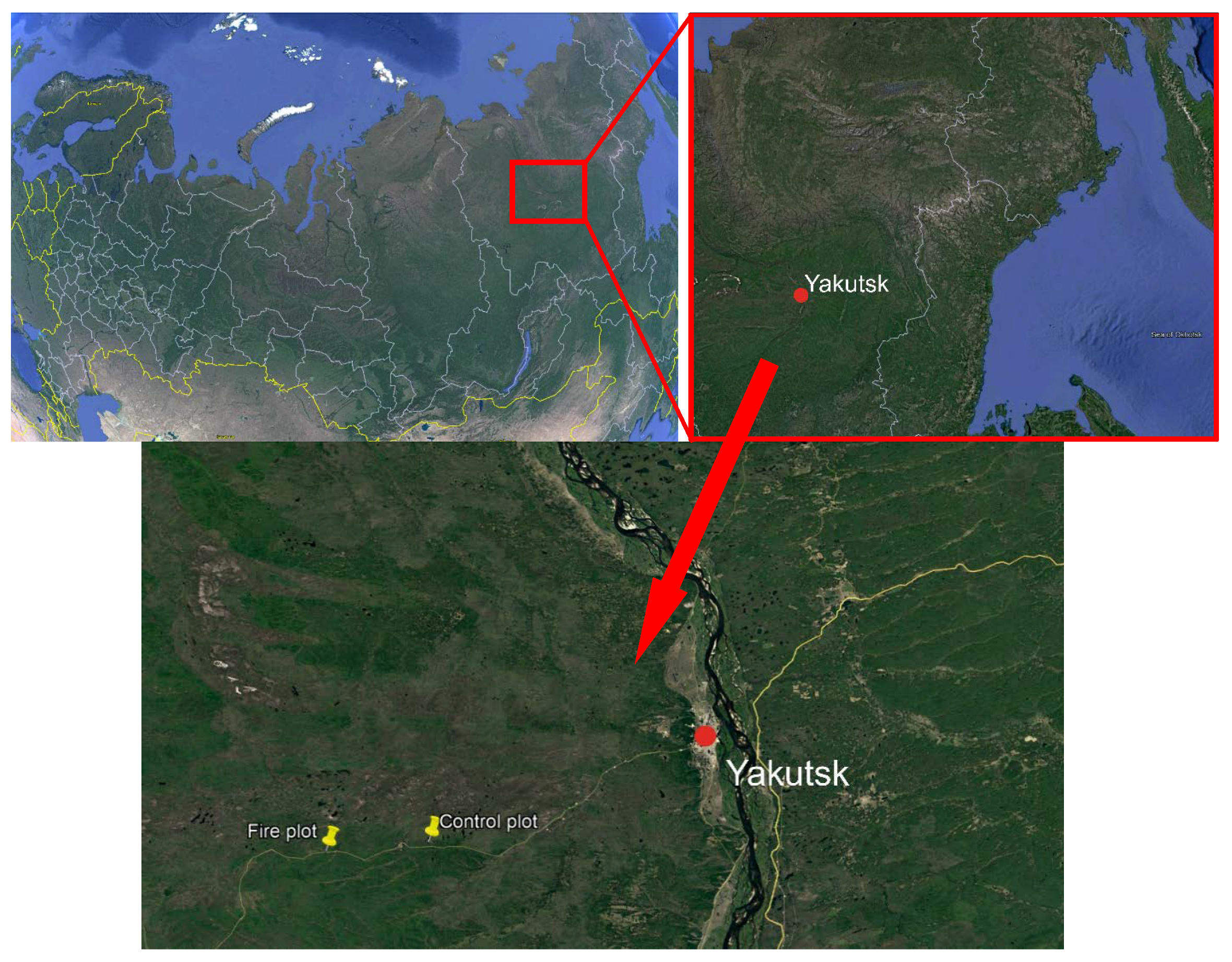
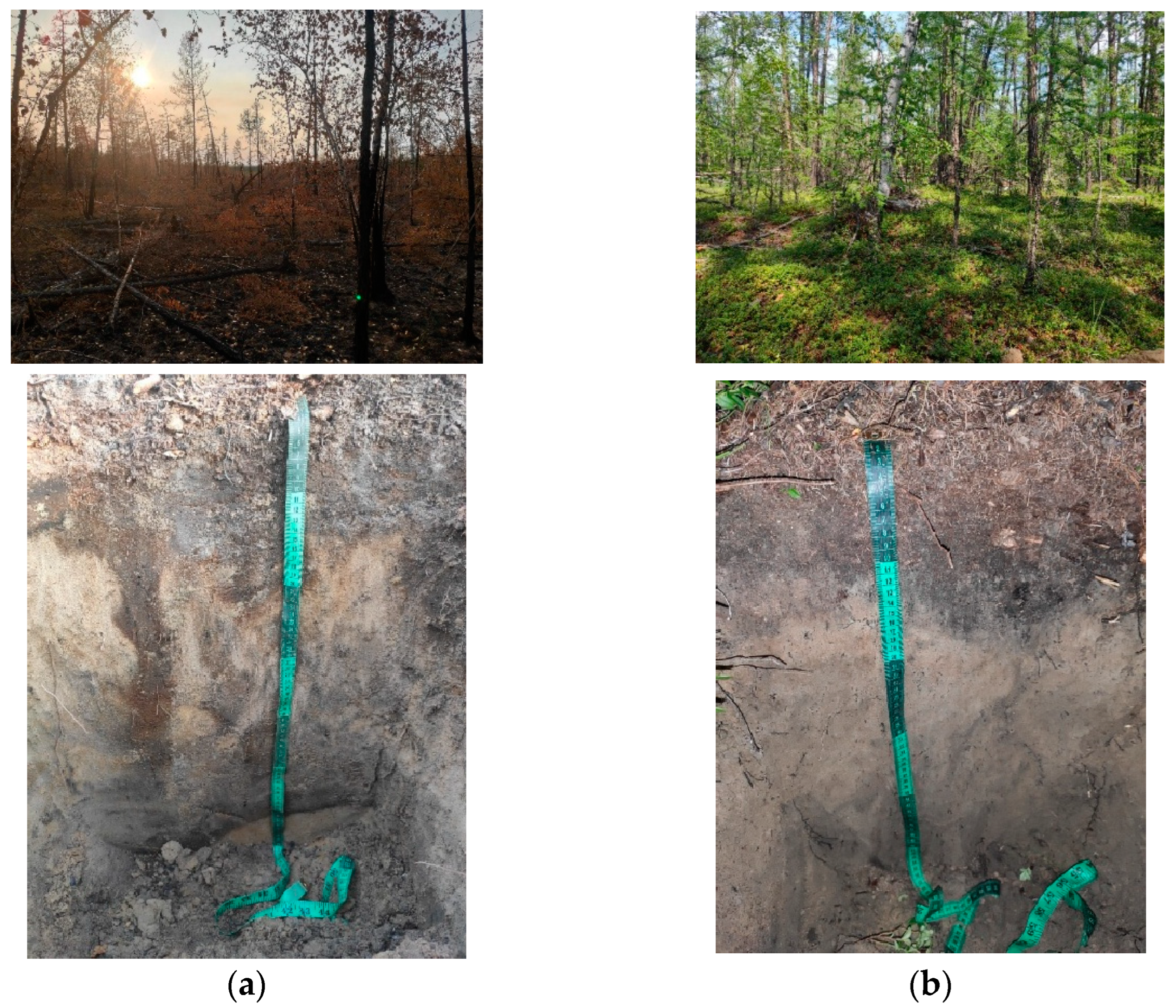
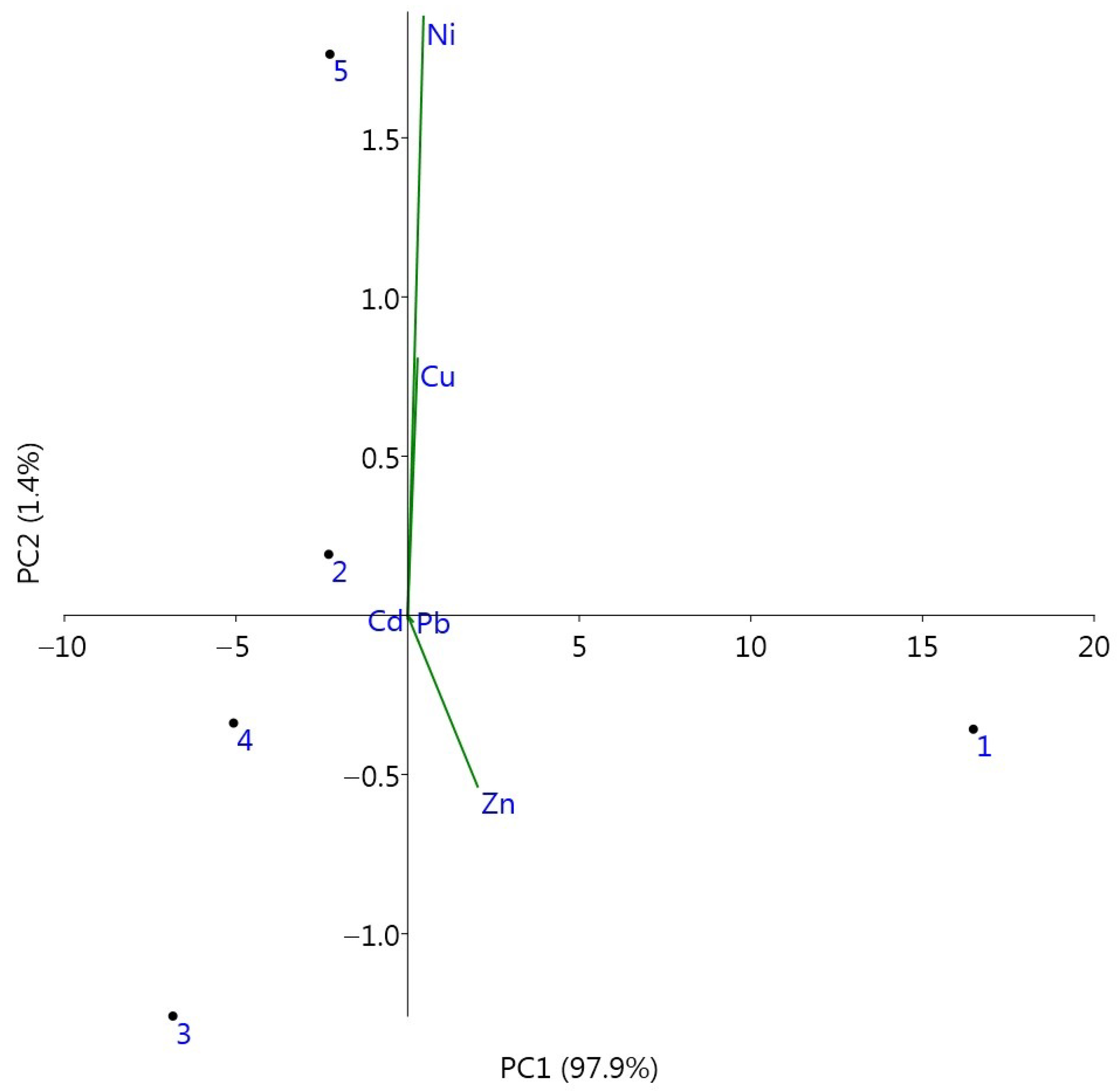
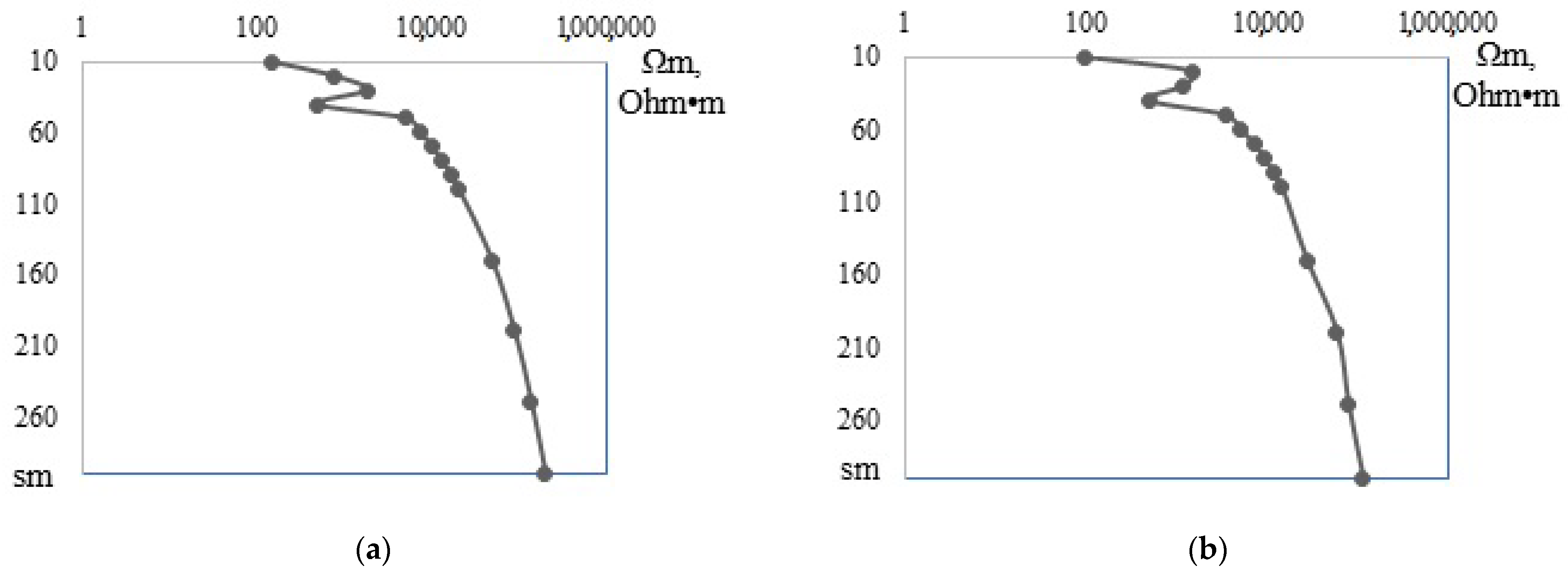
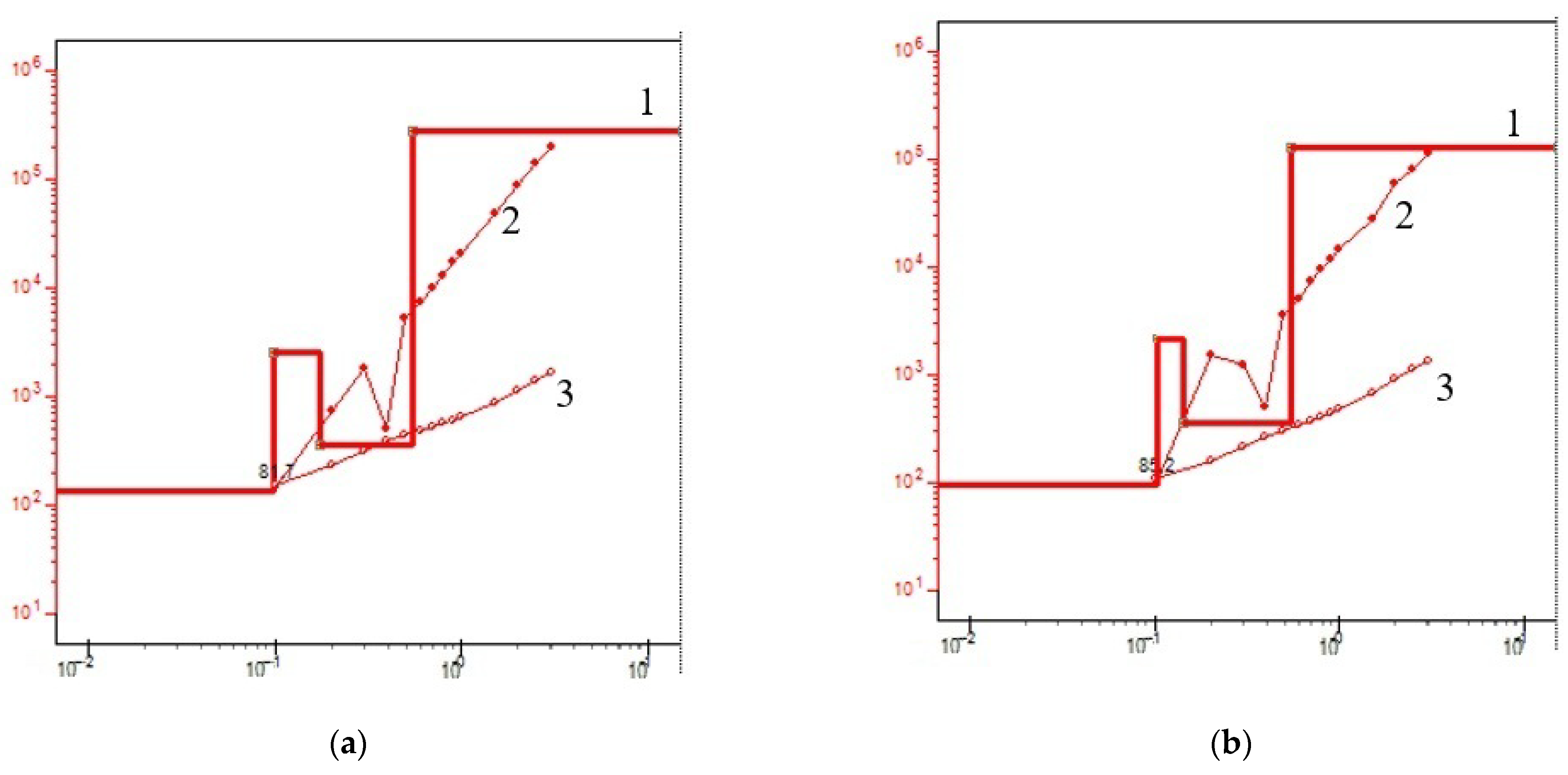
| Plot | Depth, cm | Soil Horizon Descriptions | Particle Size Distribution |
|---|---|---|---|
| Burned plot | |||
| Ah | 0–15 | Horizon with accumulation of organic matter, pyrogenic, dark-gray, moist, humus streaks (up to 50 cm), coal inclusions. | Light loam, silty–sandy |
| A/B | 35–50 | Streak of organic matter after fire, dark-gray, moist. | Light loam, silty–sandy |
| Bs | 15–70 | Horizon with stagnic conditions and illuvial concentration, light-gray, humus streaks, rust spots. | Light loam, clay–sandy |
| Control plot | |||
| Oi | 0–5 | Forest litter, slightly decomposed organic matter | |
| O/A | 5–13 | Transitional horizon, organomineral horizon, dark-gray, inclusions of raw organic material, presence of roots, not compacted, not straight border, color transition. | Light loam, silty–sandy |
| Bs | 13–40 | Illuvial accumulation of sesquioxides, iron spots, light-gray, rusty spots, finely cloggy, gradual transition, not clear boundary. | Light loam, clay–sandy |
| B/Ck | 40–55 | Transitional horizon, accumulation of pedogenic carbonates from parent materials, light-gray, darker than the previous one, structureless. | Light loam, silty–sandy |
| Plot | Horizon, Depth, cm | Ctotal, % | Vbasal | Cmic | |
|---|---|---|---|---|---|
| Burned | Ah, 0–15 | 5.0 | 2.49 ± 0.02 | 34.47 ± 0.11 | 0.02 ± 0.01 |
| A/B, 35–50 | 6.0 | 1.42 ± 0.03 | 25.12 ± 0.05 | 0.01 ± 0.01 | |
| Bs, 15–70 | 5.9 | 0.40 ± 0.05 | 15.58 ± 0.07 | 0.01 ± 0.02 | |
| Control | Oi, 0–5 | 4.5 | - | 249.46 ± 0.13 | 0.73 ± 0.07 |
| O/A, 5–13 | 5.8 | 1.95 ± 0.12 | 40.62 ± 0.09 | 0.57 ± 0.12 | |
| Bs, 13–40 | 5.8 | 0.23 ± 0.03 | 25.00 ± 0.12 | 0.49 ± 0.09 | |
| B/Ck, 40–55 | 6.2 | 0.26 ± 0.06 | 37.60 ± 0.07 | 0.06 ± 0.07 | |
| Post hoc test Burned–Control | 0.91 | 0.45 | p ≪ 0.05 | p ≪ 0.05 | |
| Significance of differences | Insignificant | Insign | Sign | Sign |
| Plot | Horizon, Depth, cm | Cu | Zn | Ni | Pb | Cd | Zc | Soil Pollution Index |
|---|---|---|---|---|---|---|---|---|
| Burned | Ah, 0–15 | 5.62 | 30.30 | 9.92 | 3.10 | 0.06 | 4.99 | 0.3 |
| Bs, 15–70 | 4.32 | 12.00 | 5.85 | 1.96 | 0.07 | 2.24 | 0.2 | |
| Control | O/A, 0–13 | 2.50 | 8.04 | 3.86 | 1.39 | 0.10 | 1.15 | 0.1 |
| Bs, 13–40 | 1.67 | 9.57 | 5.69 | 1.50 | 0.06 | 2.05 | 0.1 | |
| B/Ck, 40–55 | 3.85 | 11.70 | 7.73 | 1.67 | 0.07 | 3.08 | 0.2 | |
| Regional background values [49] | 12.6 | 20.5 | 2.2 | 6.2 | 0.9 | |||
| Plot | P-Modeled Resistivity (Ω m) | Z-Bottom Layer Depth (m) | Layer Thickness (h), m |
|---|---|---|---|
| Burned | 135.54 | 0 | 0.098 |
| 2520.00 | 0.098 | 0.075 | |
| 357.14 | 0.17 | 0.37 | |
| 279,769.00 | 0.55 | ||
| Control | 96.94 | 0 | 0.10 |
| 2171.40 | 0.10 | 0.039 | |
| 357.14 | 0.14 | 0.41 | |
| 128,264.98 | 0.55 |
Publisher’s Note: MDPI stays neutral with regard to jurisdictional claims in published maps and institutional affiliations. |
© 2022 by the authors. Licensee MDPI, Basel, Switzerland. This article is an open access article distributed under the terms and conditions of the Creative Commons Attribution (CC BY) license (https://creativecommons.org/licenses/by/4.0/).
Share and Cite
Chebykina, E.; Polyakov, V.; Abakumov, E.; Petrov, A. Wildfire Effects on Cryosols in Central Yakutia Region, Russia. Atmosphere 2022, 13, 1889. https://doi.org/10.3390/atmos13111889
Chebykina E, Polyakov V, Abakumov E, Petrov A. Wildfire Effects on Cryosols in Central Yakutia Region, Russia. Atmosphere. 2022; 13(11):1889. https://doi.org/10.3390/atmos13111889
Chicago/Turabian StyleChebykina, Ekaterina, Vyacheslav Polyakov, Evgeny Abakumov, and Alexey Petrov. 2022. "Wildfire Effects on Cryosols in Central Yakutia Region, Russia" Atmosphere 13, no. 11: 1889. https://doi.org/10.3390/atmos13111889
APA StyleChebykina, E., Polyakov, V., Abakumov, E., & Petrov, A. (2022). Wildfire Effects on Cryosols in Central Yakutia Region, Russia. Atmosphere, 13(11), 1889. https://doi.org/10.3390/atmos13111889







